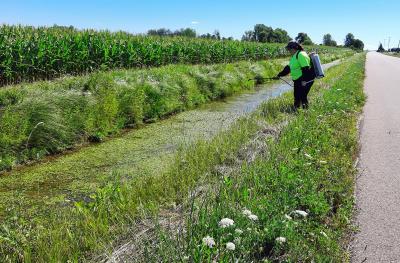The USDA Forest Service provided $50,000 to the Saginaw Bay Cooperative Invasive Species Management Area (CISMA) to establish a two-person strike team to monitor and prioritize invasive plant species including phragmites and Japanese knotweed. The Saginaw Bay watershed is the largest in Michigan and Saginaw Bay itself hosts a critically important and expansive Great Lakes coastal wetland system. The Saginaw Bay CISMA established a two-person strike team to monitor and prioritize invasive plant species.
During the last two years, the strike team monitored over 700 acres for invasive plants and treated over 250 acres to control phragmites, Japanese knotweed, and European frog-bit population and spread. Two shoreline sites, one just south of Au Gres and another just north of Sebewaing, along with roadsides and a few private parcels were treated for phragmites primarily during 2023 using the grant funding. Japanese knotweed treatments were also conducted in multiple locations. Invasive plants were either sprayed with herbicide on the ground or water, or pulled from the water during the treatments.
Saginaw Bay CISMA and the Michigan Department of Transportation coordinated and shared their data to treat Japanese knotweed on public highways and private parcels. Working with the Arenac County Road Commission, Saginaw Bay CISMA also placed signs about the CISMA’s treatments for phragmites throughout the roadside treatment area in the county, particularly in areas that had long stretches of phragmites.



